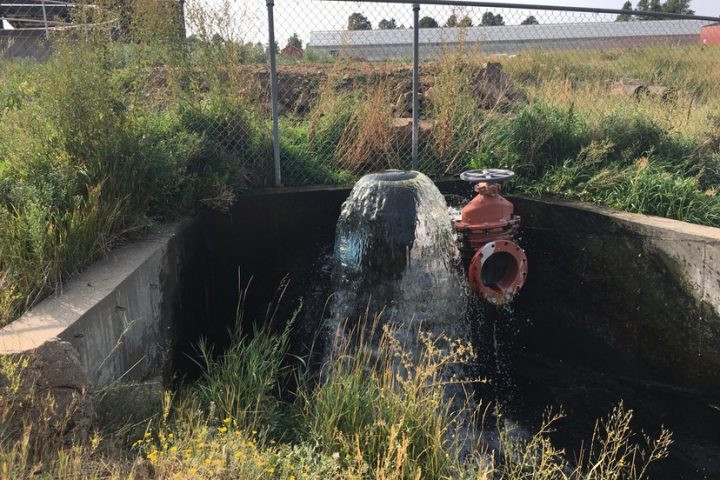Got a call from a friend who follows the Board meeting discussions at Pagosa Area Water and Sanitation District (PAWSD), letting me know about the nitrogen problem.
At the September PAWSD board meeting, District Manager Justin Ramsey noted — for the board’s edification — that the Colorado Department of Public Health and Environment (CDPHE) was going to begin enforcing Regulation 85 here in Pagosa Springs, and would be requiring PAWSD to reduce the amount of inorganic nitrogen released in the outflow at the Vista Waste Water Treatment Plant.
The estimated cost of the necessary treatment plant modifications? Perhaps as much as $12 million… to be paid for by PAWSD sanitation customers. That would come to an average of maybe $3,000 per household, according to my pocket calculator.

Nitrogen is literally everywhere. It makes up 80 percent of the air we breathe, as a simple gas, N2.
Nitrogen gas has little economic value, but when it combines with, say, hydrogen or oxygen, into different molecules, plants can use the nitrogen to build proteins… and humans and animals can consume those plant proteins to build their own bodies.
Nitrogen compounds are necessary to life, but — as they say — too much of a good thing is not a good thing.
When we live in a community that treats waste water from flush toilets, we each contribute troublesome nitrogen compounds to the treatment process. Part of the work performed by PAWSD involves the diversion of raw water into various treatment facilities, to produce safe drinking water for the majority of Archuleta County residents — mainly, those living in the Pagosa Lakes subdivisions, and those living in downtown Pagosa Springs. Another part of the PAWSD operation accepts waste water from those same areas, and ‘cleans’ the dirty water — so that it can be returned to the environment without harming humans and other forms of life.
The folks responsible for setting state standards for clean drinking water, and ‘clean’ waste water, work at the Colorado Department of Public Health and Environment (CDPHE). We note that this department is not merely concerned with ‘human’ health; they are also looking out for the environment in general. Colorado didn’t always concern itself with the way our waste water impacted non-human life forms, probably because the impacts went mostly unnoticed… or maybe because we simply didn’t care about ‘lower’ forms of life.
That uncaring attitude has changed, over the past 50 years or so… especially among those who are less than 50 years old, perhaps.
Certainly, the attitude at CDPHE has been in flux, as we learn more about how human behaviors affect public health and the environment. As the attitudes change, so do the state regulations. And so does the cost of, say, treating waste water.
One of the chemicals found in our local waste water is ammonia, a noticeable component of urine. Ammonia is a compound of nitrogen and hydrogen, NH3… a solution of which you can conveniently purchase in a plastic bottle, at the local grocery store, for cleaning purposes. Industry has numerous uses for ammonia as well, including refrigeration.
But too much ammonia can kill you. And it can kill other forms of life.
CDPHE writes:
Nitrogen and phosphorus are nutrients that are a part of all aquatic ecosystems and are necessary to support the growth of the algae and aquatic plants that provide food and habitat for fish and smaller aquatic organisms. However, excess nitrogen and phosphorus, or nutrient pollution, can cause water quality problems that result in serious risks to human and animal health and damage to the economy. Too much nitrogen and phosphorus in the water causes algae to grow faster than ecosystems can handle. Large growths of algae are called algal blooms. Some algal blooms are harmful to humans because they produce elevated toxins and bacterial growth that can make people sick if they come into contact with polluted water, consume tainted fish or shellfish, or drink contaminated water…
…Algal blooms can severely reduce or eliminate oxygen in the water, leading to illnesses in fish and other aquatic life, and the death of large numbers of fish.
During the waste water treatment process, ammonia can be converted into less dangerous forms of nitrogen. Unfortunately, even the less dangerous forms of nitrogen cause problems. In 2012, CDPHE decided to tackle nitrogen problems in Colorado with a new regulation. Regulation 85 put stricter limits on the amount of nitrogen (and phosphorus) municipal treatment plants could release into the environment.
Apparently CDPHE didn’t want to tackle the nitrogen problem too aggressively, however… because Regulation 85 applied to municipal (“point source”) waste water treatment plants… but placed no regulations on the Colorado industry that regularly contributes significant amounts of (“non-point source”) phosphorus and nitrogen to our lakes and streams: agriculture. Farms, stockyards, and ranches.
We can understand why CDPHE might have decided to begin by regulating municipal facilities. It’s a fairly simple thing to measure the amount of nitrogen and phosphorus flowing out of a single pipe, in milligrams per liter. You step up to the pipe, collect a liter of water, and do a couple of standardized chemical tests. Simple. Then you slap a fine on the facility operator, if necessary.
Measuring the amount of phosphorus and nitrogen contributed to our water system by a 10,000 acre farm? Not such a simple matter, perhaps.
According to the video above, CDPHE might decide to tackle the agriculture industry in 2022, if there haven’t been improvements in the state’s water situation.
But for 2020, one of the places where CDPHE wants to see improvement is Archuleta County…

